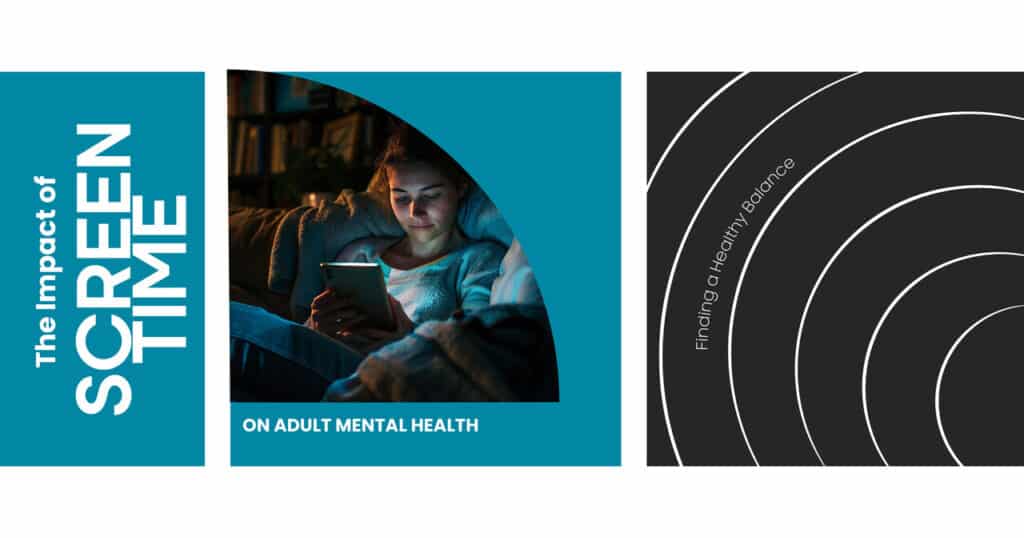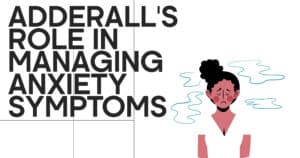In today’s digital age, our lives revolve around screens, whether it’s for work, entertainment, or social connection. While technology has brought many benefits, it has also introduced challenges, particularly regarding mental health. For many adults, excessive screen time has led to increased stress, anxiety, sleep problems, and a lack of real-life connections.
Essential Takeaways
- Find a Healthy Balance: Limiting screen time and practicing mindfulness can improve your relationship with technology and boost mental well-being.
- Prioritize Real-Life Connections: In-person interactions and tech-free activities help reduce loneliness and strengthen emotional health.
- Take Breaks When Needed: If digital demands feel overwhelming, take time to unplug and recharge to avoid burnout.
Finding a healthy balance between screen time and mental health is critical for well-being. In this article, we’ll explore the impact of screen time on adult mental health, provide practical tips for reducing screen use, and share ways to create a healthier relationship with technology.
The Connection Between Screen Time and Mental Health
Screen Time Affects Anxiety and Depression
No wonder that excessive screen time, especially on social media, results in increasing anxiety and depression. Constant messages always-on notifications, and the endless scroll of updates overload people’s minds. Their design is to make one addicted, encouraging comparisons of lives and incorporating imbalances that increase the stress level.
It is very easy to start feeling like you’re falling behind when scrolling through perfect images and curated lifestyles for hours. This kind of mentality can fuel anxiety and depression. The longer you spend behind screens, the less time available is spent on sports, communication, or interacting with other people-all of which are critical to sound mental health.
California Mental Health
The Impact of Screen Time on Sleep Quality
The truth is, very few people are aware of how their sleep could be affected by screen time. Too much time on the screen might disturb your sleeping pattern, especially if spent right before bedtime. Phones, tablets, or computers all produce blue light that impacts the natural production of melatonin, which is a hormone by the body in charge of regulating sleep; hence, interfering with falling and staying asleep, and usually causing poor quality or insomnia.
Moreover, non-sleeping time has long been known to be a psychopathology factor that can very likely facilitate anxiety, depression, and irritability. It also makes us incapable of handling stress, and our emotions remain out of control.
Physical Symptoms and Mental Strain from Screen Use
Excessive screen time now affects not only your mind but also your body. Continual staring at a computer or mobile phone leads to eye strain, headaches, neck pain, and tension in your shoulders and back. All these physical aches and pains enhance the sensations of stress and anxiety.
Many people also suffer from something commonly known as “tech neck,” a condition wherein poor posture from looking down at screens leads to chronic neck and back pains. This carries with it a kind of physical cost that accrues over time to mental exhaustion and frustration in a feedback loop between physical discomfort and mental well-being
Signs You’re Spending Too Much Time on Screens
Feeling Restless Without Your Phone
If you experience anxiety or irritability when you are unable to use your mobile phone, it may indicate damage to your mental wellbeing due to excessive phone screen use. Many of us have actually been conditioned to unconsciously reach for our phones whenever we find ourselves having a spare moment: waiting in line, sitting down on the couch. Such continuous stimulation also makes it hard to stay present at the moment or become interested in real-life interactions.
Decline in Productivity or Focus
Decreased productivity is also another sign that your screen time is probably causing you harm. After sitting for hours on your phone, computer, or tablet, you may feel you cannot work on your work, schoolwork, or personal tasks. These developments may lead to having a tendency to procrastinate while sitting at work; opening social media in the middle of work; or mentally getting exhausted at the end of the day.
One disadvantage of screens as distractions is that they not only hinder work productivity but also lead to feelings of guilt and frustration that could spread into anxiety and stress.
Deteriorating Social Connections
While technology helps keep in touch with the world, too many screens may indeed be watered down at the expense of real-time connections with fellow human beings. Should you find that you spend more time communicating online with other people than spending time with your loved ones, it’s high time to reassess your screen life.
It sometimes happens that social media interactions only give a person the feeling of being lonely, unattached to those who matter most, but in-person connections also provide more intense emotional support leading to good mental health.
California Mental Health
Tips for Reducing Screen Time and Improving Mental Health
Set Boundaries for Screen Use
Perhaps one of the most effective ways to cut down on screen time is to set limits. Decide upon specific times in a day that you are going to put your phone away or turn off your computer. Establish, for example, that you will not have “screens” at all while eating or before sleep. This allows you to be much more present in the moment and gives your mind a break from constant stimulation.
Establishing screen-free time in the evening can also help improve your sleep. Try turning off devices at least an hour before bedtime to reduce blue light exposure and promote better rest.
Engage in Tech-Free Activities
A person can also fill the day with tech-free activities, such as taking a walk or reading a book. Practicing yoga, even an hour at home with the family, can dislodge the habit of constant screen use. This will not only give your eyes and brain relief but will also enable you to reignite hobbies or passions probably pushed to the wayside because of excess screen time.
Practice Mindful Screen Use
If you cannot help but cut down on screen time, then you can try mindful screen use. Mindful screen use is all about being intentional with your how and when of screen use. That is to say, you’re not mindlessly scrolling through social media, you actually set a purpose for this screen use. For instance, you’re limiting social media time to 20 minutes or using apps only for specific work tasks.
You can also try the “20-20-20 rule” for curbing eye strain, every 20 minutes, take a 20-second break and look at something 20 feet away. This can cut down on some of the physical ravages of long screen sessions.
Digital Detox and Social Media Breaks
A digital detox can be a very effective means of resetting and refocusing your relationship with technology. Taking a break from screens, in particular social media, allows for better real-world connections while recharging one’s mind and reducing stress. You do not need to cut out screens completely; sometimes, just taking a break for a day or on a weekend will restore mental freshness.
During a digital detox, you can focus on activities that bring you joy or relaxation, such as spending time outdoors, pursuing creative hobbies, or catching up on sleep.
How to Create a Healthier Tech-Life Balance?
Prioritize Real-Life Interactions
Real-life connections are very essential to the mental well-being of people. Though technology may easily connect people with friends and family, face-to-face interactions should be seen as much as possible. Face-to-face conversations help make emotional bonds between people deeper, as much as they reduce loneliness and provide support in trying times.
Spend some time with your friends, family, or colleagues without using any screen-based devices by planning out your week to allocate more time for that. Such bonding moments are good for your mental well-being.
Implement Tech-Free Zones in Your Home
Establish areas in the home that are screen-free. These zones will make you spend less time on screens and promote more mindful living, suggests Elizabeth Oates. She recommends designating specific rooms in the house, like the bedroom or dining room, as screen-free. That way, it leaves open the possibility of resting, eating, and socializing uncluttered by digital systems.
This also contributes to healthier boundaries between work and relaxation, especially among those who are work-from-home individuals. Spaces, minus screens, are great areas for unwinding, which promotes mental and emotional well-being.
Use Technology to Support Your Well-Being
At times, screens contribute to problems in mental health, but at the same time, when used mindfully, they help improve well-being. In fact, many mental health-related apps can be found, including meditation apps, sleep track, and digital wellness tools to monitor one’s time of screen use.
It would let you have the best benefit out of the gadget without letting the device take over your life. It helps in creating healthier habits toward recording self-logged progress and balancing screen time with self-care.
When to Seek Help: Recognizing Digital Burnout
What Is Digital Burnout?
Digital burnout occurs when the demands of screen use, whether from work or personal life, overwhelm your mental and physical health. Symptoms of digital burnout include chronic fatigue, emotional exhaustion, difficulty concentrating, and a lack of motivation.
Should these symptoms arise, take a step back and reassess your relationship with technology. Ignoring the signs might lead to critical effects on your mental state in case of digital burnout.
How to Address Digital Burnout?
First of all, it’s important to identify the symptoms of digital burnout. You will likely feel exhausted, disconnected from life, or both if you are using excessive amounts of screen time. Turn off your screens at work, take care of yourself, and reconnect with things that make you happy.
In more severe cases, you should definitely consult a mental health worker, as therapy or counseling can guide you through these feelings of burnout and develop strategies to maintain a healthier balance between screen time and mental health.
California Mental Health
FAQs
- How much screen time is too much?
There’s no one-size-fits-all answer, but experts recommend limiting recreational screen time to 2-3 hours per day for adults.
- Can reducing screen time improve mental health?
Yes! Reducing screen time can lead to better sleep, decreased anxiety, improved focus, and more time for meaningful activities.
- What are some alternatives to screen-based relaxation?
Alternatives include reading, exercising, spending time outdoors, meditating, or engaging in hobbies like cooking or crafting.
- How can I tell if screen time is affecting my mental health?
Look for signs like poor sleep, irritability, eye strain, difficulty focusing, or feeling disconnected from loved ones.
- What are the best ways to reduce social media use?
Set time limits for social media apps, schedule social media-free days, and engage more in face-to-face interactions.







